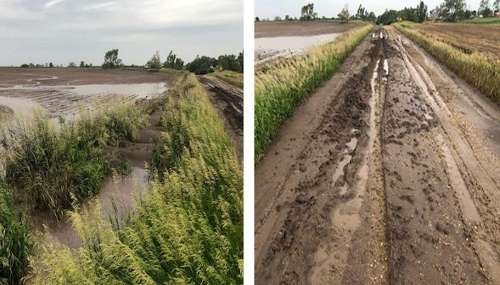By David Kringen
On June 8-9, 2020, a severe weather system moved across Southeastern South Dakota producing heavy rainfall, high winds and hail. According to the National Weather Service, the prolonged nature of the event was driven by Tropical Depression Cristobal, which lifted north along the Mississippi River Valley on these 2 days before eventually turning northeast towards the Great Lakes Region. This south-north moving system blocked the weather pattern from its normal progression and resulted in storms tracking through the areas west of Interstate 29 from the evening of June 8 through the afternoon of June 9.
This extreme weather event damaged trees, power lines, and buildings in the area. Damage to unprotected cropground was also documented in some areas as well. A combination of tillage, no residue, and lack of crop canopy can lead to severe erosion and topsoil loss in the face of extreme weather patterns in the spring. The most effective strategy for producers to adapt to these extreme events is to improve soil health.

A combination of wind and water erosion has resulted in severe topsoil loss in this field after the latest extreme weather event. According to the NRCS Soil Conservationist, the no-till field next to it had no noticeable soil loss.
Soil Health Principles
Soil health, although often viewed as a ‘buzz phrase’ in agriculture, is vital to the protection of our land now and for the generations to come. The five principles of soil health are as follows:
- Soil Armor: Simply put, we want to keep the soil covered with a growing root and/or crop residue. This helps to control erosion, reduce evaporation rates, reduce compaction due to rainfall (soil crusting), suppress weeds, and provide habitat for living soil biology.
- Minimize Soil Disturbance: Soil disturbance happens in many ways such as overgrazing, over-application of nutrients and pesticides (disrupting the soil food web functionality), and tillage. When soil is disturbed, especially with tillage, water infiltration is restricted and water has a higher tendency to runoff soil surfaces rather than infiltrate. Soil disturbances can result in water and wind erosion, ponding water, soil crusting, and soil organic matter depletion.
- Plant Diversity: The native prairie was a very diverse perennial landscape; mimicking this type of cropping system helps us to work with nature rather than against it. Keeping a diverse crop rotation helps to maintain good plant diversity. This would include a mixture of warm season grasses and broadleaves (for example, corn and soybean) as well as cool season grasses and broadleaves (for example, wheat and pea). Maintaining plant diversity improves rainfall infiltration and nutrient cycling, and helps to break up pest cycles in cash crops.
- Living Roots: Keeping a diverse crop rotation as discussed in the 3rd principle, helps to keep a living root in the soil. In addition, cover crops are also an excellent way to keep a living root in the soil. By doing so we help to increase water infiltration, keep the soil covered, recycle soil nutrients, improve water quality, suppress weeds, integrate livestock, and more!
- Livestock Integration: Fall and winter grazing provide an excellent way to convert high carbon annual crop residue into low carbon organic material. Animals also help to reduce nutrient export from cropland and hayland through grazing. Livestock aid in managing weed pressure by grazing and lessen pressure on perennial grasslands in the fall.
Keeping soils protected through the soil health principles can help avoid issues like those pictured here. By implementing the five principles of soil health, producers can look forward to positive changes to their soils over time. Although improvements may not be obvious overnight, long term improvements will likely be seen for years to come.
Source : sdstate.edu